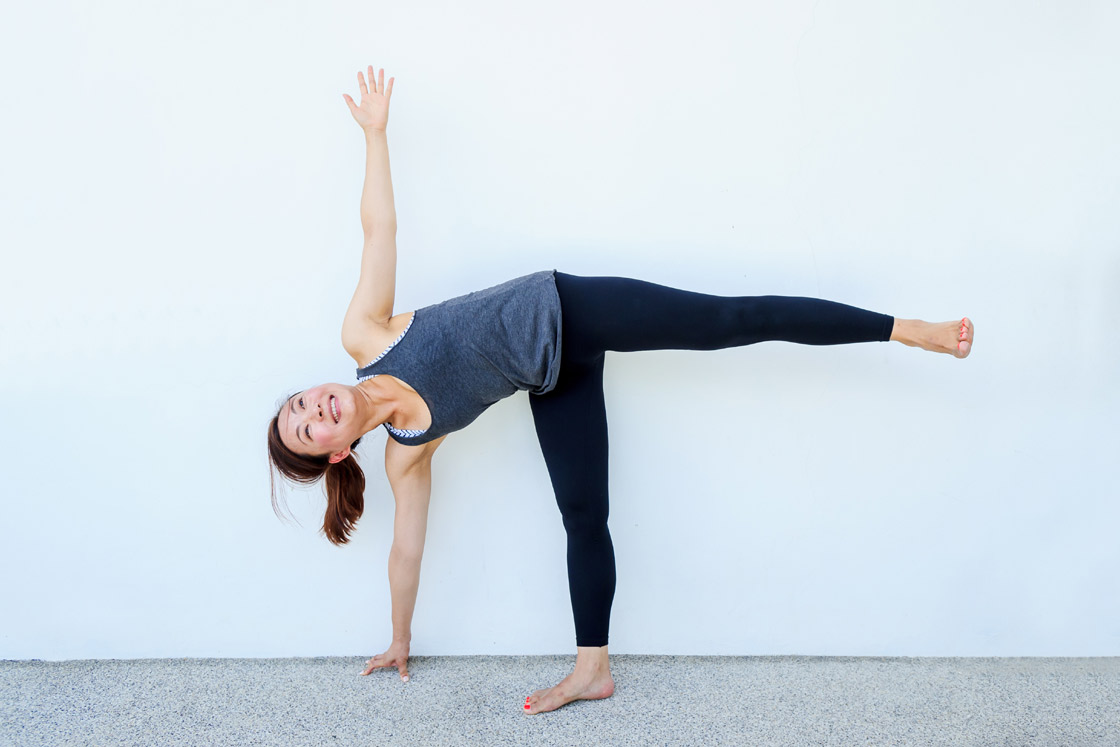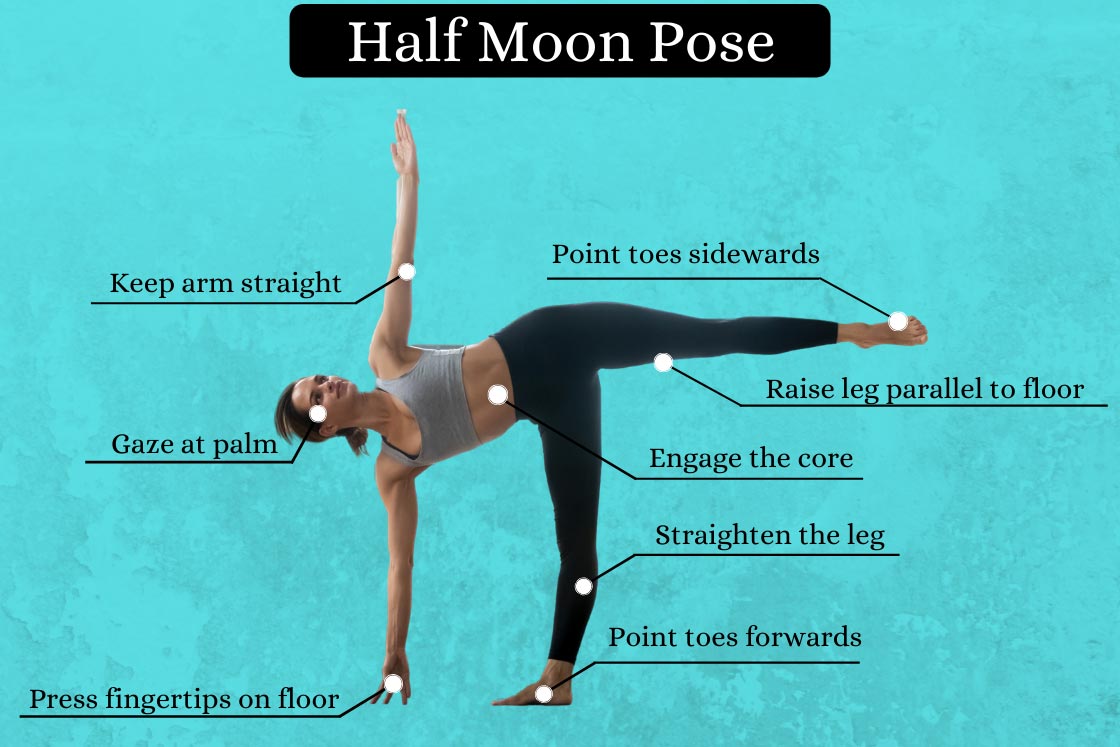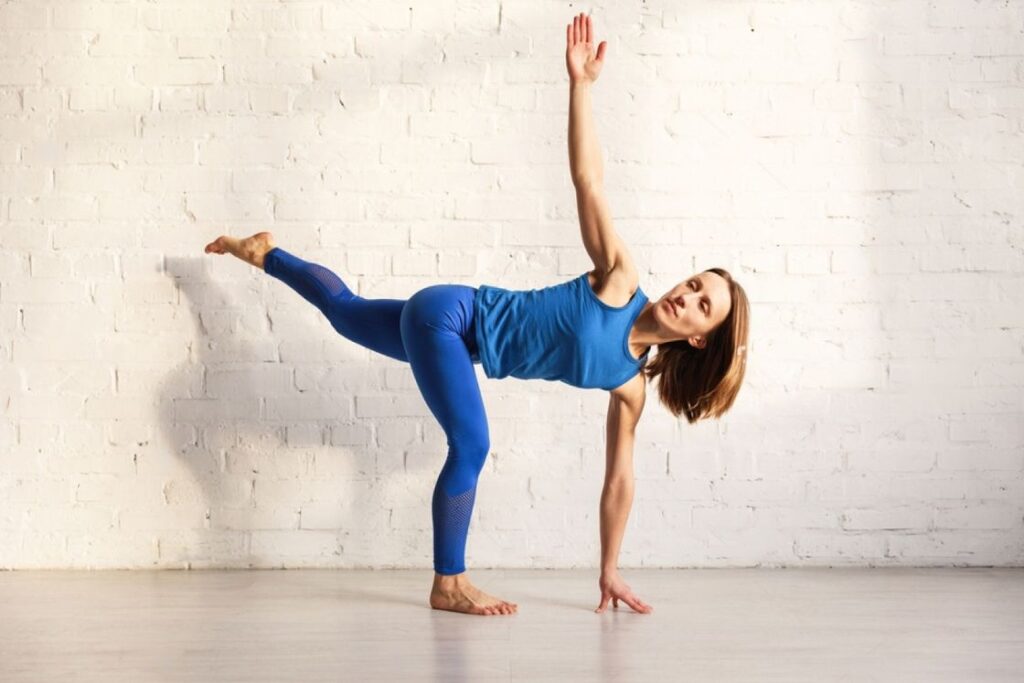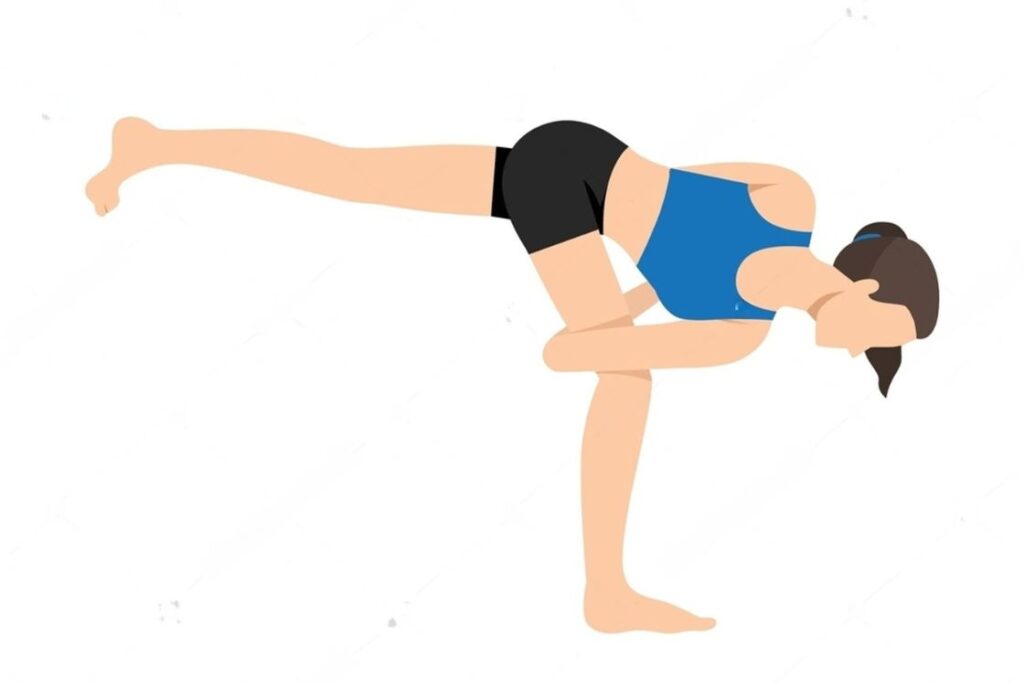
| Sanskrit | Ardha Chandrasana (ARDH-uh CHUN-drahs-uh-nuh) (अर्ध चंद्रासन) |
| Meaning | Ardha = Half / Chandra = Moon / Asana = Pose |
| Type | Intermediate, standing balance, stretching |
| Level | Intermediate |
| Anatomy | Ankles, knees, thighs, hamstrings, hips, waist, lower back, core, arms, shoulders |
| Other Names | Half Moon Pose |
The Half Moon Pose, or Ardha Chandrasana in Sanskrit, is an intermediate yoga pose that enhances balance, strength, and flexibility. This pose challenges both the body and mind, requiring focus and concentration, making it a valuable addition to any yoga practice.
Half Moon Pose is often included in sequences aimed at improving stability and core strength, providing a strong foundation for more advanced balancing poses. It engages multiple muscle groups, including the legs, hips, core, and shoulders, which helps improve overall body coordination and proprioception.
Meaning
The name Ardha Chandrasana is derived from three Sanskrit words: Ardha, meaning “half,” Chandra, meaning “moon,” and Asana, meaning “pose.” This pose is inspired by the shape of a half-moon, symbolizing balance, illumination, and reflection. In yoga, the Half Moon Pose represents the moon’s ability to balance light and darkness, embodying the quest for harmony within the body and mind. Practicing Ardha Chandrasana fosters strength, balance, and poise, cultivating a sense of calm and focus, much like the serene presence of the moon in the night sky.
The Half Moon Pose also reflects the dual nature of yoga, blending effort with ease and strength with grace. Different yoga traditions interpret this pose uniquely. In Sivananda Yoga and its derivative styles, such as the Bihar School of Yoga, the Half Moon Pose is known as Anjaneyasana and is often included in the moon salutation series (Chandra Namaskar).
In contrast, in Bikram Yoga, “Half Moon Pose” refers to a two-legged standing side bend, also known as Indudalasana in other traditions.
Practice guide half moon pose (Ardha Chandrasana)
Before starting the practice guide for Half Moon Pose, it’s important to grasp its key benefits and alignment principles. This pose improves balance, strengthens the core and legs, and enhances overall body coordination. Focusing on proper technique and alignment is vital for achieving these benefits and maintaining safety throughout your practice.
Preparatory poses
- Triangle Pose (Trikonasana)
- Warrior Pose I (Virabhadrasana I)
- Warrior II (Virabhadrasana II)
How to do half moon pose(steps)

- Start in Triangle Pose (Trikonasana) with your right foot forward. Place your right hand on your shin or the floor and extend your left arm towards the ceiling.
- Shift your weight onto your right foot by bending your right knee slightly and moving your right hand about a foot in front of your foot. Keep your hand on the floor or a block.
- Lift your left leg parallel to the floor, keeping it straight and strong with toes pointing outward.
- Open your left hip so it stacks above your right hip. Rotate your chest to face the side of the mat and extend your left arm straight up.
- Find your balance by gazing at a point on the floor or towards your left hand. Engage your core and breathe steadily to maintain stability.
- Hold the pose for 5-10 breaths, focusing on lengthening your lifted leg and spine.
- To release, gently lower your left leg back to the floor and return to Triangle Pose. Repeat on the other side.
Beginner tips
- Use a yoga block for support if you can’t reach the floor.
- Practice next to a wall for extra stability.Keep a slight bend in your standing leg to help with balance.
- Focus on one spot to improve concentration and stability.
- Move slowly into and out of the pose to prevent injuries.
- Use a strap around your raised foot if needed for better alignment.
Precautions
- If you have balance or dizziness issues, practice the pose near a wall or use a block for extra support.
- If you experience lower back pain, use a block under your hand or avoid the pose to reduce strain.
- If you have wrist or shoulder injuries, ensure your weight is evenly distributed and consider using a block under your hand for additional support.
- Maintain proper alignment by stacking your hips and keeping your chest open. Avoid collapsing your torso or letting your lifted leg sag.
- Engage your core muscles to support your lower back and maintain balance. Avoid overextending or straining your back.
- If you experience sharp or intense pain, ease out of the pose and stretch only within a comfortable range.
- Use a yoga block or wall for added support and stability, especially if you are new to the pose.
Contraindications
- Avoid this pose if you have recent or chronic injuries to the wrists, shoulders, hips, or lower back.
- Pregnant individuals, especially in later stages, should avoid this pose due to potential strain on the abdomen and balance concerns.
- Those with high blood pressure should avoid this pose or consult a healthcare provider beforehand, as balancing on one leg can affect circulation.
- Individuals with hip or knee issues should be cautious, and may need to avoid or modify the pose to prevent aggravating their condition.
- People with glaucoma or other eye conditions should avoid looking up or straining their neck while performing the pose.
- If you experience severe dizziness or significant balance issues, avoid this pose or practice it with support from a wall or block.
- Those who have recently undergone abdominal or hip surgery should avoid this pose until fully healed and cleared by a medical professional.
Follow Up Poses
Variations
- Revolved Half Moon Pose (Parivrtta Ardha Chandrasana): Incorporates a twist to challenge balance and core strength further.

- Bound Revolved Half Moon Pose (Baddha Parivrtta Ardha Chandrasana): Adds a bind to the Revolved Half Moon Pose for deeper stretching and enhanced balance.

Benefits of half moon pose
The Half Moon Pose directly enhances balance and stability while strengthening the legs, core, and shoulders. It also improves flexibility in the hips and lower back, aiding in overall mobility. Additionally, this pose helps relieve stress and supports digestive health.
- Improves Balance and Stability: The Half Moon Pose requires balancing on one leg while holding the body in a lateral position. This challenges and enhances your overall balance and stability, which can help in everyday activities and other yoga poses.
- Strengthens Leg Muscles: Balancing on one leg while lifting the other engages the glutes, quadriceps, and hamstrings. This strengthens the leg muscles, which improves overall lower body strength and endurance.
- Opens Hips and Shoulders: The pose stretches and opens the hips and shoulders, increasing flexibility and range of motion. This can help alleviate tightness and improve posture.
- Enhances Core Strength: Maintaining balance in the Half Moon Pose requires strong core engagement. This strengthens the core muscles, including the abdomen and lower back, which supports better posture and stability.
- Stretches the Spine and Back: By extending the body and reaching one arm towards the ceiling while the other reaches down, the pose provides a deep stretch for the spine and back muscles. This can help relieve tension and improve spinal flexibility.
- Improves Digestive Health: The pose stimulates and massages the abdominal organs, which can aid digestion and relieve constipation. This gentle internal massage supports better digestive function.
- Relieves Menstrual Discomfort: The stretching and strengthening involved in the pose can help alleviate menstrual cramps and discomfort by increasing blood flow and reducing tension in the lower abdomen.
- Reduces Stress: The focus required to balance in the Half Moon Pose helps clear the mind and reduce stress. The pose encourages mindfulness and concentration, which can have calming effects on the nervous system.
- Boosts Overall Flexibility: The pose stretches multiple areas of the body, including the hips, legs, and spine, which enhances overall flexibility and range of motion.
Conclusion
Half Moon Pose (Ardha Chandrasana) is a versatile yoga posture that challenges your balance and strengthens your core, legs, and hips. As a key component of various yoga practices, it helps cultivate stability and coordination. When performing this pose, it’s crucial to pay attention to alignment and use props if needed, especially if you have any pre-existing conditions or balance concerns.
Practicing Half Moon Pose with proper technique and mindfulness can enhance your overall yoga experience and support your journey toward greater physical and mental balance.
Half moon pose faqs
Yes, but beginners may need modifications like using a block for support.
Hold the pose for 20-30 seconds on each side, gradually increasing as you build strength and balance.
Half Moon Pose builds on Triangle Pose by adding a balance component and lifting one leg while extending the other arm upward.
Yes, it enhances flexibility in the hips and legs while also improving overall body coordination.
Avoid collapsing your torso, letting your lifted leg sag, and ensure proper alignment of your hips and shoulders.
Practice regularly, use props like blocks, and focus on core engagement.
It is generally safe, but listen to your body and modify as needed.
Avoid it if you have recent or chronic injuries to the wrists, shoulders, hips, or lower back, or if you experience severe dizziness or balance issues.
The post Half Moon Pose (Ardha Chandrasana): Steps, Variations & Benefits appeared first on Fitsri Yoga.